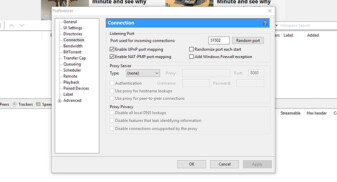
However, I’ve read a few times this leaks (IP or DNS, I forget). Some people use this, like to VPN the QB connection only, but use other stuff (like internet browser) at the same time going through their normal internet connection (not the VPN). I ended up contacting PIA and they said technically it can’t be used with their port forwarding. I read a few places that said this is needed when port forwarding, but hard to find info on.


Could potentially block a site you don’t want it to (or Enable and test/use it until it does this).ĭedicated IP - Not used.
Private internet access utorrent settings torrent#
Should I Enable this? I’m not familiar with it, but it seems more relevant to normal VPN internet browsing rather than for torrents as long as you’re using common/familiar torrent sites and not clicking obvious ads (or have ad-blocker). It sounds like this stops any normal internet usage when VPN is off, which I do not want. I don’t see a reason to use this if you’re already binding QB to your VPN. Privacy > Advanced Kill Switch - Disabled. Although I’ve read it can possibly fail and still leak (depending on how it fails which is why it’s important to also bind QB to your VPN), I see no reason to disable it. Maybe if you had a server or Plex (I’m not familiar with that though) on your network and saving files to, it’d be necessary to have this Enabled, idk. Should I disable this? If I understand its meaning, as in devices on my home network (my router), then this is not necessary for me and probably safer to disable. Network > Allow LAN Traffic - Kept default Enabled. Using this allows connection to more seeds/peers, and overall has increased my DL/UL speeds. Having enabled it, I can connect to a port-forward enabled server (non-US), PIA gives me a 5-digit port number which I then open QB and paste it into QB settings > Connection > Listening Port > “Port used for incoming connections”. My understanding is that port forwarding has some minor risks, mainly related to how secure/trusted the app you’re port forwarding is itself (qBittorrent in this case), and any issue would be incredibly rare (if any ever at all with qBittorrent?), so I’m using it. Network > Request Port Forwarding - Originally kept default Disabled, but I recently Enabled it.

I’ve heard about “Handshake” before, and I see “Handshake DNS” as an option here not sure if they’re the same, just haven’t messed with it. I’d guess small packets would be faster for torrents specifically, but I will switch it back to Auto for now. Protocols > MTU - Not sure why I had this on “Large Packets” since “Auto” is default. Protocols > Protocol - Originally kept default “OpenVPN”, but I’ve read a lot about WireGuard being faster and more secure so I’ve switched to it. Screenshots of my current settings from both PIA VPN and qBittorrent here: IMGUR LINK I’ve searched/read a lot about it, but info is scattered in many different places/posts, and sometimes outdated or contradicting so I appreciate any advice or corrections. I want to ensure I have good/correct settings to remain anonymous/not leak/etc. I use Private Internet Access (PIA) as my VPN, qBittorrent (QB, that I switched to recently) as my torrent client, and mostly 1337 or RARBG.


 0 kommentar(er)
0 kommentar(er)
